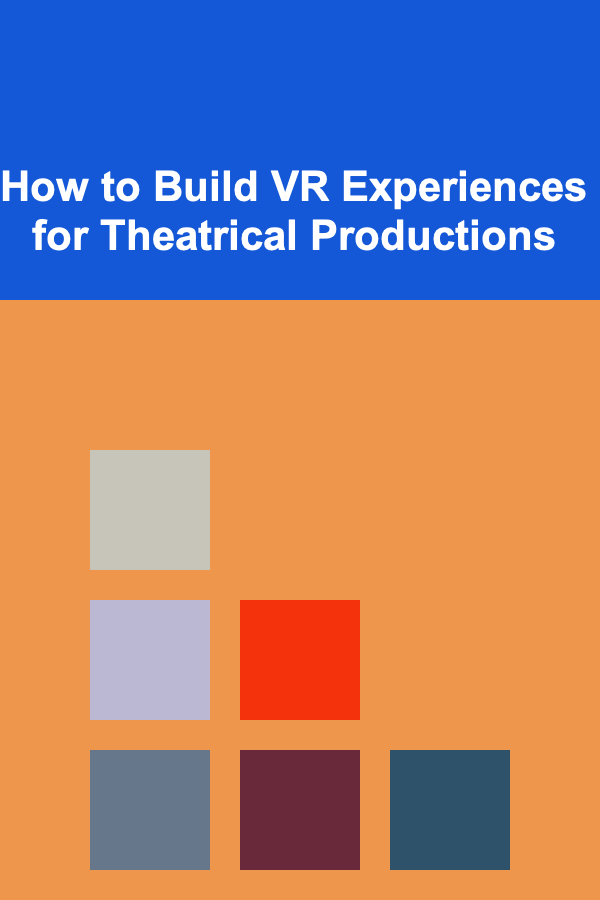
How to Build VR Experiences for Theatrical Productions
ebook include PDF & Audio bundle (Micro Guide)
$12.99$11.99
Limited Time Offer! Order within the next:

Virtual Reality (VR) has made significant strides in various sectors, from entertainment and gaming to healthcare and education. However, one of its most exciting applications lies in the realm of the theater. As technology continues to evolve, the potential for creating immersive, interactive experiences for theatrical productions is expanding. VR is revolutionizing the way theatergoers experience live performances, offering new opportunities for storytelling, audience engagement, and stage design. This article will explore how to build VR experiences for theatrical productions, examining the creative possibilities, the technical requirements, and the steps involved in integrating VR into live theater.
Understanding the Role of VR in Theater
Before diving into how to build VR experiences, it's important to understand why VR is becoming an essential tool in theatrical productions. The immersive nature of VR can transport the audience to completely different worlds, enhance performances, and allow for a deeper connection to the story being told.
1.1 Enhancing Immersion
Traditional theater relies on physical sets, props, and actors to create an immersive experience. However, VR can push this concept further by allowing audiences to step inside the performance, interact with the characters, and explore the world from a first-person perspective. This creates a multi-sensory experience that can deepen emotional engagement and make the narrative more impactful.
1.2 Expanding Creative Possibilities
Incorporating VR into theater allows for new types of storytelling. Imagine a performance where actors interact with virtual elements, or a production that takes place in an entirely virtual world. The possibilities for scenic design, costume creation, and staging are nearly limitless when combined with VR technology. Directors and designers can create environments that would be impossible to achieve with traditional methods, such as scenes set in outer space, underwater, or in fantastical realms.
1.3 Interactivity and Audience Engagement
One of the most exciting aspects of VR in theater is the potential for interactivity. While traditional theater typically involves a passive audience, VR can enable more active participation. Audience members could navigate through scenes, make choices that impact the direction of the story, or even communicate with actors in real-time. This can turn a typical play into a truly immersive, participatory event.
Key Components of VR for Theatrical Productions
Creating a VR experience for theater requires a combination of various technical and creative components. Each element needs to work together seamlessly to create a believable, engaging experience for the audience.
2.1 VR Hardware
To create a VR experience, you need to have the right hardware. This includes VR headsets, controllers, and tracking systems.
- VR Headsets: The headset is the most important part of the VR experience. It displays the virtual environment to the user and provides feedback through stereoscopic 3D visuals. Popular VR headsets include Oculus Rift, HTC Vive, and PlayStation VR.
- Motion Controllers: These controllers are used to track the user's hands and enable interaction with the virtual world. In theatrical productions, they could allow audience members to interact with the environment or engage with actors.
- Tracking Systems: To ensure that the audience's movements are reflected accurately in the VR environment, a reliable tracking system is essential. This could include external cameras or sensors that track the user's position and movements.
2.2 Software Development
Building a VR experience for a theatrical production involves creating virtual environments and interactive elements. This requires a strong understanding of VR development and the use of specialized software.
- Game Engines: Most VR experiences are built using game engines such as Unity or Unreal Engine. These platforms allow you to create 3D environments, control animations, and implement interactive elements. Unity, for example, is popular for its ease of use and robust asset store, while Unreal Engine is favored for high-quality graphics and real-time rendering.
- 3D Modeling and Animation Software: To create the virtual world and its elements, you will need 3D modeling software such as Blender, Maya, or 3ds Max. These programs allow you to create realistic virtual environments, characters, and objects that will be placed into the VR world.
- Programming and Scripting: For more advanced interactivity, you'll need to write scripts that control the behavior of the virtual elements. This can involve coding in languages such as C# (for Unity) or Blueprints (for Unreal Engine), depending on the platform you're using.
2.3 Sound Design and Music
Sound plays a crucial role in creating an immersive VR experience. In a theater production, sound is typically used to enhance the atmosphere and support storytelling. In VR, sound design must be even more intricate, as it contributes to the sense of presence and realism in the virtual world.
- Spatial Audio: In VR, the audience's perception of sound is crucial for immersion. Spatial audio technologies simulate 3D sound, allowing users to perceive where sounds are coming from in the virtual environment. This could be particularly effective in creating dramatic moments or heightening tension in a performance.
- Real-time Sound Interaction: VR also allows for real-time audio manipulation. For example, sound effects could change based on a user's actions or location within the virtual world, further enhancing the interactive aspect of the experience.
2.4 Lighting and Visual Effects
Just as lighting is an essential element in traditional theater, it plays an important role in VR as well. Lighting in VR helps set the tone, define space, and guide the audience's attention.
- Dynamic Lighting: In VR, lighting can be adjusted in real-time, allowing for dramatic changes throughout the performance. Dynamic lighting can be used to simulate different times of day, weather conditions, or emotional shifts in the narrative.
- Visual Effects: Beyond basic lighting, VR also allows for the implementation of advanced visual effects, such as smoke, fire, and particle systems. These effects can be used to enhance key moments in the performance, making them feel more visceral and lifelike.
Designing VR Experiences for Theatrical Productions
Building a VR experience for theater is not simply about creating a 3D world; it's about designing an experience that complements the narrative and engages the audience. Here are the steps involved in the design process.
3.1 Conceptualization and Storyboarding
Just like any theatrical production, the first step in creating a VR experience is conceptualizing the story. What is the theme of the performance? What are the emotional beats you want to highlight? These questions should guide the creation of the virtual environment and interactions.
- Storyboarding: A storyboard is a visual representation of how the VR experience will unfold. It helps outline the narrative flow, key moments, and interactions between the audience and the virtual world. Storyboarding also allows you to plan how the audience will interact with the environment, and it serves as a reference for the development team.
3.2 Scene Design and Virtual World Building
Once the narrative is established, you can begin designing the virtual world. This involves creating 3D models of the sets, props, and characters, and ensuring that they fit seamlessly into the performance.
- Environment Design: The design of the virtual environment must reflect the tone and atmosphere of the production. For example, a horror-themed VR play would require dark, eerie environments, while a fantasy production may call for vibrant, fantastical landscapes.
- Set Interaction: In VR, the audience can interact with the set in ways that are impossible in traditional theater. Consider how the audience will navigate the space, what objects they can interact with, and how they can influence the story.
3.3 Audience Interaction and Immersion
Interactivity is a key feature of VR experiences in theater. The design should focus on how the audience can engage with the virtual world and the performers.
- Interactive Narratives: One way to integrate interactivity is through branching narratives. The audience could make decisions that affect the outcome of the story, similar to interactive video games. For example, an audience member might choose which path a character takes or what action they should perform.
- Real-time Interaction with Actors: Actors can interact with the audience in real-time, responding to their actions and adjusting the performance based on the choices the audience makes. This can create a more personalized experience, as the audience becomes part of the narrative.
3.4 Testing and Refining the Experience
After the VR experience is designed, it's essential to test it with real audiences to ensure that everything works as intended. Testing can reveal any issues with the user interface, the pacing of the story, or the overall immersion.
- User Testing: Conduct testing with people unfamiliar with the production to ensure that they can navigate the VR world and understand the story. Feedback from these test groups can help refine the experience and improve the overall design.
- Performance Testing: Because VR experiences can be resource-intensive, it's important to test the performance of the system. Ensure that the virtual environment runs smoothly, with no glitches, delays, or frame rate issues that could disrupt the experience.
Integrating VR into Live Performances
While VR is often associated with fully virtual experiences, it can also be integrated into live theatrical productions. Here are some ways to incorporate VR into a live performance.
4.1 Hybrid Productions
One approach is to combine live action with VR elements. For example, actors could perform in front of a physical set while the audience wears VR headsets to experience a parallel, virtual world. This hybrid approach allows for a more traditional theater experience while still incorporating the immersive elements of VR.
4.2 Immersive Theater
In immersive theater, the audience is actively involved in the performance, moving around the space and interacting with the actors. VR can enhance this by creating dynamic environments that shift based on the audience's actions. For example, audience members might wear VR headsets during specific scenes and interact with virtual elements that influence the narrative.
4.3 Virtual Set Extensions
Another way to integrate VR into live theater is by using virtual set extensions. In this setup, the actors perform on a physical set, while the audience views additional virtual elements through VR headsets. This allows for the use of fantastical or large-scale environments that would be difficult to achieve with physical sets alone.
Conclusion
Building VR experiences for theatrical productions offers a unique way to push the boundaries of traditional theater. By combining the immersive power of VR with the art of storytelling, creators can offer audiences a new type of performance that engages all of the senses. While the technical aspects of building a VR experience are complex, the creative potential is immense, providing endless opportunities for innovative, interactive performances. As VR technology continues to evolve, the possibilities for theater will only grow, paving the way for a new era of immersive storytelling.

How to Boost Your Rental Property's Value with Small Improvements
Read More
How to Make Money with Deep Learning: A Comprehensive Guide
Read More
How to Mix High and Low-End Decor on a Budget
Read More
The Comprehensive Guide to Graphic Design: Best Practices and Tools for a Successful Career as a Specialist
Read More
Understanding the Biology of Sea Turtles
Read More
10 Tips for Planning a Drought-Tolerant Garden
Read MoreOther Products

How to Boost Your Rental Property's Value with Small Improvements
Read More
How to Make Money with Deep Learning: A Comprehensive Guide
Read More
How to Mix High and Low-End Decor on a Budget
Read More
The Comprehensive Guide to Graphic Design: Best Practices and Tools for a Successful Career as a Specialist
Read More
Understanding the Biology of Sea Turtles
Read More